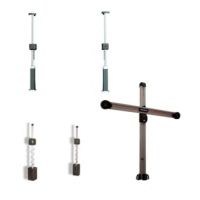25
Theory of Operation
RELATIVE CAMERA POSITIONING (RCP)
It would be easy to say that we know the distance between the cameras because we designed and manufac-
ture the Camera Beam and cameras. However, the knowledge the aligner must have about the relationship
of one camera to another is critical and must be known to high level of precision – manufacturing tolerances
in the beam and camera assemblies are too variable to be counted on. When the aligner is installed the
technician mounts the cameras onto the beam. Later, the technician performs a camera aim in which he/she
alters the position of the cameras. NOTE: The V3400 does not required camera aim. Once all camera move-
ments are completed it is time for us to help the program nd out where the cameras are with respect to each
other. We must perform Relative Camera Positioning.
THE FIXTURE
The xture used to perform RCP and can also used for camera aiming. It is easy to use the clamp and target
assemblies placed on the runway to aim cameras. It must be clear that RCP is performed at the factory and
is not required unless a camera is replaced or moved.
The xture consists essentially of a bar about 5.5 feet in length with a target attached on each end (a front
and rear). Stands are used to place it on the alignment rack, which should be at alignment height so the
targets are visible to the cameras. Due to manufacturing tolerances and transportation of the xture, we can-
not be sure its dimensions are the same as the design. We must measure it each time we perform RCP. Of
course, we always have a highly accurate measurement tool at our disposal – the 3D Aligner. To measure the
length of the xture we place the assembly on the right runway of the rack in the view of the right camera.
The right camera measures the distance to the front target and the rear target, and subtracts the two with the
difference being the xture length. This is stored in memory for usage later in the RCP procedure.

